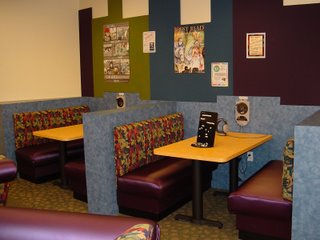
Getting Young Adults interested in attending the library for the right reasons is a challenge. One reason, the interests of a 13 year old vs. that of 17 year old can be light years. A fundamental question should also be asked, have teens and their interest really been considered? When I was growing up I spent very little time in the library, I was interested in comics and graphic novels, which at the time was beneath the library. Fortunately times have changed and so have many of the attitudes of the libraries. In any given library you will find anime, graphic novels and computers with online access But what about space? What sort of challenges are there in creating a space for a loud and boisterous group
Above is teen room in the 1970's below addresses reflects our current attitude


In Correlations between Teen Spaces & Teen Behavior
May 11, 2006 - Filed under: Reflections, Advocacy — Stephanie Librarian @ 5:19 pm
In the Resources to Young Adults class this past semester at the University of Pittsburgh, we embarked on a class discussion about the correlation between teen spaces and teen behavior. The class was assigned the task of observing a teen library, taking note of teen behaviors, and finally, discussing our findings as a group.
A handful of my classmates visited a particular library that had problems with teen patrons. The children’s librarian did not like teens, and there was not a teen librarian around to balance out this viewpoint. She referred to the group of repeat teen visitors as a “gang of goth teens” — the “gang” association being the disturbing part of that description because it assigns a criminal attribute to the group. The behavior of the said “gang” was exhibited by their congregation around the entrance of the library. The librarian reported that the teens gave patrons bad looks and made them feel uncomfortable. They also talked loud when they were inside the library, usually hanging out around the teen books section.
This example is just one of many where librarians associate the teen demographic with negative behavior, and refuse to see things from the perspectives of teens. In most libraries the reaction of staff to disruptive teen behavior is to label the group as troublemakers, and to disassociate them from the status of “library patron.” Through this disassociation, the librarians are no longer liable for trying to work with the said group of teens, and can instead see them as intruders that need to be carefully watched. But we teen services advocates know that by treating the teens like criminals, we will set ourselves, as well as the teens up for failure. Staff members are usually baffled to hear that the way we can solve problems with teen behavior is to create a space for them in the library, because to them this means bringing more problems into the library, not diffusing the problem.
Throughout our class discussion, we also reflected upon the experiences that took place at libraries that had dedicated staff and space for teens. These library environments had fewer issues with disruptive behavior, and in most of these cases teens were seen to be engaging in constructive activities. Our class came to the conclusion that by giving teens recognition and tailored services, they will generally engage in positive models of behavior.
However, not all libraries have the recourses to hire teen staff or create a teen space. In these cases, even the smallest improvements can make a mile of difference. One of my classmates noted that after she moved near the “goth gang” to browse the teen collection and acknowledged the group with a smile, she found that the volume of their discussion lowered and they quit “horsing” around. Her observation was that by having some small interaction with teens, and recognizing them as being worthy of attention, their behavior can suddenly change to a more constructive mode. A smile and small conversation is something even the smallest of libraries can certainly afford.
I think the significance of these observations is that they illustrate the need for teen librarians to be advocates. We are still in an age where teen library services are not exactly a top priority. How do we respond to this lack of awareness? One of the best ways that we as teen librarians can make a difference is to inform our peers and colleagues about the importance of teen services in the most informal, grassroots way possible. Slow days at the circ desk can result in some progressive conversation about the value of serving teens, and the reasons we do what we do. I also personally believe that infiltrating a culture from the ground up can make a large difference, which is why I tend to advocate for grassroots methods of gaining support.
What are the techniques you use to advocate teen library services at
your place of work?